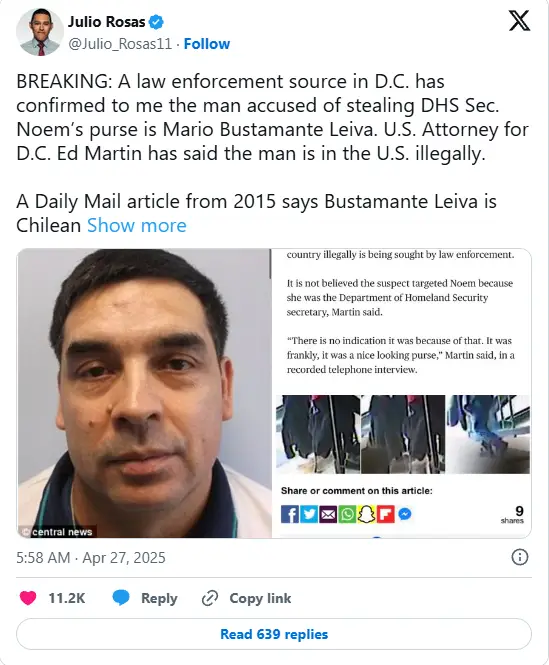NOTE:IDENTITY REVEALED AT THE END OF ARTICLE.
The Incident: What Happened Over Easter Weekend
1.1 Setting the Scene: A Family Easter Dinner
On the evening of Saturday, March 30, Secretary Noem chose The Capital Burger—a casual eatery located roughly one mile from the White House—to celebrate Easter with her immediate family. With interior lighting bathing the dining room in a warm glow and a moderate holiday crowd, patrons enjoyed classic American fare while live acoustic music provided ambiance. The restaurant’s proximity to federal buildings and frequent visitation by staff and tourists alike has made it a popular spot for both casual diners and occasional public-figure appearances.
1.2 The Theft Unfolds
According to the police complaint, Noem placed her Louis Vuitton Clemence shoulder bag—retailing for $4,400—on the floor next to her chair. Containing more than $3,000 in cash, her government credentials (including a driver’s license, passport, and DHS badge), and apartment keys, the bag represented both significant monetary and security risk.
At approximately 7:15 p.m., surveillance footage captured a masked individual—wearing an N95 surgical mask, dark pants, a fur-collared jacket, and a baseball cap—appearing to scout the dining room. The thief approached Noem’s table, used a foot to snag the purse handle, dragged the bag several steps behind a coat for concealment, and exited through the main entrance. No one in the party noticed the theft until they found the bag missing moments later.
1.3 Immediate Aftermath
Noem recounted the moment in an interview on the “Vince” podcast, hosted by conservative commentator Vince Coglianese:
“I actually felt my purse—I thought it was my grandkids kicking my legs. But he hooked it with his foot, dragged it a few steps away, dropped a coat over it, and took it. It was very professionally done.”
Upon discovering the missing bag, Noem and her family alerted restaurant staff, who immediately checked security cameras. Within hours, authorities were notified, initiating a joint response by the Secret Service (tasked with protecting Cabinet members) and the D.C. Metropolitan Police Department.
2. Key Figures: Victim and Suspect
2.1 Secretary Kristi Noem: From South Dakota Governor to DHS Chief
Kristi Noem was confirmed as Secretary of Homeland Security in early 2025 after serving two terms as Governor of South Dakota. Her portfolio encompasses border security, cybersecurity, emergency response, and counterterrorism. Noem’s tenure has been marked by high-profile initiatives on unlawful migration and domestic preparedness—making her a frequent public target for both praise and criticism.
Despite the national spotlight, Noem maintains a hands-on approach to both policy and public service. Her choice of a neighborhood restaurant for a family dinner reflects her desire for normalcy amid a high-stakes job. That normalcy was shattered in an instant by a theft that exposed her personal security to risk and her professional credentials to potential exploitation.
2.2 The Suspect: An Unnamed Alleged Illegal Immigrant
Within days of the theft, law-enforcement sources told the New York Post that an individual believed to be an undocumented immigrant was in custody. According to those sources, the suspect—initially unnamed—was linked to a larger organized theft operation that has targeted high-end handbags and electronics in the D.C. metro area.
Unofficial reports on social media, including a post by Julio Rojas of Blaze Media, identified the arrested individual as Mario Bustamante Leiva, a Chilean national. Rojas cited a 2015 London arrest for a similar crime. However, U.S. Attorney Ed Martin and official spokespeople have not confirmed the suspect’s identity pending formal charging documents.
Authorities also indicated that a second suspect— another migrant believed to be in the country illegally—remains at large. Both individuals are suspected of coordinating surveillance of targets, swift grab-and-go tactics, and rapid resale through illicit channels.
3. Law-Enforcement Response: From Surveillance to Arrest
3.1 Partnership Between Secret Service and D.C. Police
As soon as The Capital Burger’s management provided video footage, the Secret Service’s protective detail and D.C. Metro Police launched parallel inquiries. The Secret Service focused on potential risks associated with the missing DHS credentials and personal data. Meanwhile, Metro Police pursued identification of the thief and recovery of stolen property.
3.2 Tracking Leads and Interviewing Witnesses
Investigators canvassed nearby surveillance cameras—from traffic lights to adjacent businesses—to trace the suspect’s escape route. They also interviewed restaurant patrons and employees. A key breakthrough came when a delivery driver’s dashcam captured a vehicle pulling away from the alley behind the restaurant at approximately the same time.
Using license-plate readers, police traced the vehicle to a neighborhood known for its high immigrant population. In collaboration with Homeland Security Investigations (HSI), detectives executed a search warrant at a nearby apartment, leading to arrests and the seizure of the stolen bag, Noem’s credentials, and additional luxury goods believed to be proceeds of organized theft.
3.3 Securing Sensitive Credentials
In addition to personal property, recovering Noem’s driver’s license, passport, and DHS badge averted potential national-security complications. The Secret Service immediately deactivated Noem’s DHS badge, issued her temporary credentials, and began the process of replacing her passport—all standard protocol when an official’s secure documents are compromised.
4. Organized Retail-Theft Rings: A Growing Concern
4.1 The Modus Operandi
Retail-theft rings in the D.C. area have evolved into sophisticated operations resembling white-collar enterprises. Rather than lone shoplifters, these groups:
-
Recruit lookouts to monitor law-enforcement presence.
-
Coordinate quick strikes on high-value targets (designer handbags, consumer electronics).
-
Use public spaces (restaurants, cafés) to case victims before snatching purses or wallets.
-
Leverage online resale platforms and “fencing” networks to launder stolen goods.
4.2 Impact on Local Businesses
According to the National Retail Federation, organized retail crime costs U.S. retailers an estimated $60 billion annually. In D.C., small businesses near tourist corridors have reported a 15–20% uptick in theft-related insurance claims over the past two years. Restaurant owners now train staff to watch for suspicious behavior—even for patrons briefly setting personal items aside.
4.3 Government Crackdowns
In response, federal and local authorities have formed task forces combining:
-
Secret Service investigators (for crimes involving government officials).
-
HSI and U.S. Immigration and Customs Enforcement (ICE) for cross-border criminal networks.
-
Metro Police’s Organized Crime Division.
These units share intelligence, coordinate enforcement actions, and pursue both criminal penalties and immigration violations when applicable.
5. Immigration Status and Policy Debates
5.1 The Role of Immigration Enforcement
The suspect’s alleged status as an undocumented immigrant has reignited policy debates. Proponents of stricter border controls argue that such crimes underscore the risks posed by illegal entry. Opponents caution against conflating immigration status with criminal propensity, noting that most undocumented immigrants do not engage in violent or organized theft.
5.2 Political Reactions
-
Supporters of tougher immigration laws have seized on the theft as evidence for expedited deportations and expanded ICE authority.
-
Civil-rights advocates warn that targeting noncitizens for high-profile crimes can fuel xenophobic narratives and distract from socioeconomic drivers of crime.
-
Bipartisan consensus: Most agree that organized theft requires targeted law-enforcement strategies regardless of an individual’s immigration status.
5.3 Legislative Outlook
In Congress, proposals under consideration include:
-
Enhanced data-sharing between ICE and local police for crimes involving stolen government credentials.
-
Funding for small-business security grants in high-risk urban areas.
-
Pilot programs pairing community outreach with enforcement to deter recidivism among undocumented offenders.
6. Security Implications for Public Figures
6.1 Protecting Personal Property
Even protected officials like Cabinet secretaries rely on ordinary public venues that lack the fortified security of government complexes. After the incident, DHS announced a review of:
-
Protocol for carrying secure documents in public.
-
Use of discrete credential carriers to reduce visibility.
-
Coordination with venue security when traveling off-site.
6.2 Risk Assessment in Public Settings
Security experts recommend:
-
Minimal public display of badges or credentials.
-
A discreet “briefcase” approach rather than open handbags.
-
Pre-visit sweeps by advance security teams when high-risk visits are anticipated.
For family dinners and personal downtime, officials often relax these measures—but as this incident demonstrates, everyday settings can become crime scenes overnight.
7. Legal Proceedings and Potential Outcomes
7.1 Charges Likely to Be Filed
Based on the recovered evidence, prosecutors are expected to charge the arrested suspect with:
-
Unlawful taking of property valued over $1,000 (felony theft).
-
Possession of stolen goods.
-
Possession of government credentials without authorization.
-
Possibility of aggravated identity theft for mishandling official documents.
If the second suspected accomplice is apprehended, similar charges—and conspiracy counts—could be added.
7.2 Sentencing Guidelines
Under D.C. Code § 22-3212, theft of property over $1,000 carries a prison sentence of up to 10 years. Federal identity-theft statutes add mandatory minimums for misuse of official documents.
Should immigration violations be proven, the suspect may face removal proceedings, compounding criminal penalties with deportation.
8. Crime Trends in Washington, D.C.
8.1 Theft and Nonviolent Crime Rates
According to the Metropolitan Police Department’s 2024 annual report:
-
Overall property crimes increased 8% compared to 2023.
-
Grand theft (over $1,000) rose by 12%.
-
Organized-theft ring indictments doubled, reflecting more coordinated enforcement.
8.2 Underlying Factors
Contributing factors include:
-
Tourist foot traffic creating plentiful targets.
-
Inflationary pressures pushing some to petty and organized theft.
-
Gaps in social-service funding leaving vulnerable populations susceptible to crime—either as victims or perpetrators.
Early 2025 data suggests that while violent crime remains near historic lows, property offenses continue an upward trajectory, prompting calls for preventive as well as punitive measures.
9. Policy Considerations and Prevention Strategies
9.1 Strengthening Local Business Defenses
Municipal initiatives may include:
-
Security-camera grants for small restaurants and shops.
-
Business watch programs, akin to neighborhood watch, coordinated with Metro Police.
-
Training for staff on identifying organized-theft behaviors.
9.2 Federal and Local Collaboration
Enhanced cooperation could involve:
-
Task forces combining ICE, Secret Service, HSI, and local police.
-
Information-sharing platforms to track theft-ring patterns in real time.
-
Community outreach to address root causes—homelessness, addiction, economic disenfranchisement.
9.3 Balancing Enforcement with Community Trust
While enforcement is essential, experts stress the importance of:
“Maintaining community trust so that all residents—regardless of immigration status—feel safe reporting crime without fear of unrelated immigration consequences.”
—Dr. Maria Rodriguez, Urban Policy Analyst
10. Conclusion
The Easter-weekend theft of Secretary Kristi Noem’s handbag—stolen by an alleged undocumented immigrant linked to an organized-crime ring—serves as a case study in the complex intersection of personal security, public policy, and urban crime prevention. Key takeaways include:
-
Rapid, coordinated law-enforcement response secured sensitive documents and identified suspects within days.
-
Organized-theft rings operate with alarming professionalism in urban centers, requiring specialized task forces.
-
Immigration status of suspects can inflame policy debates but should not overshadow the need for community-driven crime prevention.
-
Security protocols for high-profile individuals must adapt to everyday vulnerabilities.
-
Legal proceedings will test current statutes on theft, identity fraud, and unauthorized possession of government credentials.
-
Broader crime trends in D.C. highlight the need for both enforcement and social-service investment.
As the case proceeds to court and policy debates unfold in Washington, this incident reminds us that no one—regardless of rank— is immune to the everyday risks of urban life. The theft of that purse was more than a momentary embarrassment for a Cabinet secretary; it was a wake-up call to officials, businesses, and communities to bolster security, address root causes of property crime, and uphold both public safety and civil trust in the nation’s capital.






